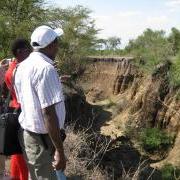Potential Field Sites
 Through the BESSA programme we have reviewed a number of studies, sites and initiatives in which assessments and analysis of the potential for rewards for environmental services to reduce poverty and prevent further deterioration in ecosystem goods and services could be analysed. In this first phase projects in Kenya and Tanzania are underway, and work in Uganda-Albertine Rift and at a further area in Republic of Guinea were also considered.
Through the BESSA programme we have reviewed a number of studies, sites and initiatives in which assessments and analysis of the potential for rewards for environmental services to reduce poverty and prevent further deterioration in ecosystem goods and services could be analysed. In this first phase projects in Kenya and Tanzania are underway, and work in Uganda-Albertine Rift and at a further area in Republic of Guinea were also considered.
Kenya
Three potential sites at which some work ha been initiated under PRESA have been reviewed. In summary these are:
Sasumua dam at the upper ridges of the AberdareMountains provides Nairobi with 20 percent of its fresh water. However, intensive human activity within the dam’s watershed is causing sedimentation and water contamination.
Poor land management, deforestation and pollution are threatening the livelihoods of 30 million people dependent upon Lake Victoria for fishing, transport, irrigation and electricity generation.
Mount Kenya is one of the five critical fresh water sources in Kenya and its rivers make up almost 49% of the country’s biggest river, the Tana.
Tanzania
The Uluguru mountains are the source of the RuvuRiver, which sustains 2.8 million people in Tanzania’s capital city Dar es Salaam.
The UsambaraMountains are an important source of water for north eastern Tanzania. The Indian Ocean cities of Tanga, Mombasa and Dar es Salaam rely on water from the UsambaraMountains.
Republic of Guinea
Fouta Djallon highlands are sources of West Africa’s most important rivers: Senegal, Gambia, Niger and Mano rivers. These rivers provide drinking water, irrigation and hydroelectric power to millions of people in Senegal, Mauritania, Gambia, Mali, Niger and Nigeria.
Uganda
The ‘Albertine Rift’ is a nature paradise for animals, birds and fish. Birdlife International has classified it as an Endemic Bird Area. The region is a biodiversity hotspot and a Priority Eco-Region as per Conservation International and World Wildlife Fund classification systems. However, there is a quiet clash over the sustainable use of ecological resources. 



